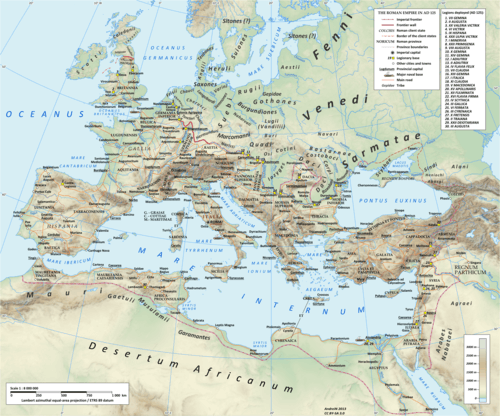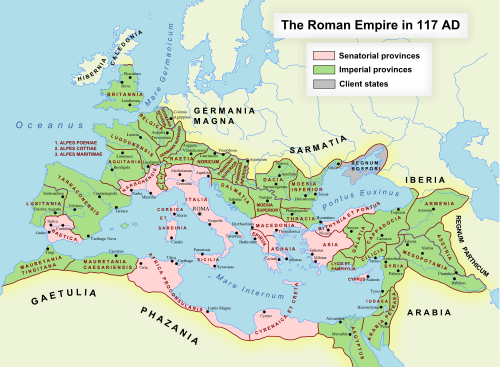Gallia Lugdunensis
Gallia Lugdunensis (French: Gaule Lyonnaise) was a province of the Roman Empire in what is now the modern country of France, part of the Celtic territory of Gaul formerly known as Celtica. It is named after its capital Lugdunum (today's Lyon), possibly Roman Europe's major city west of Italy, and a major imperial mint. Outside Lugdunum was the Sanctuary of the Three Gauls, where representatives met to celebrate the cult of Rome and Augustus.
| Provincia Gallia Lugdunensis | |||||||
|---|---|---|---|---|---|---|---|
| Province of the Roman Empire | |||||||
| 27–25 BC / 16–13 BC–486 | |||||||
 Province of Gallia Lugdunensis highlighted. | |||||||
| Capital | Lugdunum | ||||||
| Historical era | Antiquity | ||||||
• Established after the Gallic wars | 27–25 BC / 16–13 BC | ||||||
| 260–274 | |||||||
• Frankish Empire | 486 | ||||||
| |||||||
| Today part of | |||||||

History
In De Bello Gallico describing his conquest of Gaul (58–50 BC), Julius Caesar distinguished between provincia nostra in the south of Gaul, which already was a Roman province in his time, and the three other parts of Gaul: the territories of the Aquitani, of the Belgae, and of the Galli also known as the Celtae. The territory of the Galli extended from the rivers Seine and Marne in the north-east, which formed the boundary with Gallia Belgica, to the river Garonne in the south-west, which formed the border with Gallia Aquitania. Under Augustus, Gallia Lugdunensis was created by reducing in size the territory of the Galli: The portion between the river Loire and the Garonne was given to Gallia Aquitania, and central-eastern portions were given to the new province of Germania Superior. The map shows the extent after these reductions. The date of the creation of Gallia Lugdunensis is under discussion, whether between 27 and 25 BC or between 16 and 13 BC, during Augustus' visits to Gaul.
It was an imperial province, deemed important enough to be governed by an imperial legate. After Diocletian's Tetrarchy (AD 296), it was the major province of a diocese confusingly called Galliae ('the Gaul provinces'), to which further only the Helvetic, Belgian (both also Celtic) and German provinces belonged; with the dioceses of Viennensis (the southern provinces of Gaul), Britanniae (also Celtic) and Hispaniae (the whole Celtiberian peninsula) this formed the praetorian prefecture also called Galliae, subordinate to the western emperor.
The province effectively ceased to exist in AD 486 when the Roman general Syagrius was defeated by the invading Franks.
Governors
- c. 21: Acilius Aviola[1]
- 66-69 Junius Blaesus[2]
- 78-80: Titus Tettienus Serenus[3]
- 80-83: Gaius Cornelius Gallicanus[4]
- 83-87: Lucius Minicius Rufus[5]
- Between 123 and 130: Tiberius Claudius Quartinus[6]
- Between 126 and 137: Titus Vitrasius Pollio[6]
- c. 146-149: Titus Flavius Longinus Quintus Marcius Turbo[7]
- Between 138 and 161: [...] Pacatus[7]
- Between 138 and 161: [...]latin Pi[...]atus[8]
- 161-162: Gaius Popilius Carus Pedo[9]
- Between 161 and 168: Lucius Aemilius Frontinus[8]
- Between 160 and 169 or 177 and 180: [...] Egr[ilius Plarianus Larcius Lep]idus [Flavius ...][8]
- 187–188: Septimius Severus[10]
- c. 195-198: Titius Flavius Secundus Philippianus[11]
- c. 218: Tiberius Claudius Paulinus[11]
- 220-222: Marcus Aedinius Julianus[11]
- After 223: Badius Comnianus[11]
Fiction
The fictional unconquered village from the French comic book Asterix is located here, on an Armorican peninsula (modern Brittany).
See also
References
- Tacitus, Annales, III.41.1
- Tacitus, Histories, III.38
- Werner Eck, "Jahres- und Provinzialfasten der senatorischen Statthalter von 69/70 bis 138/139", Chiron, 12 (1982), pp. 320-324
- Eck, "Jahres- und Provinzialfasten", pp. 304-306
- Eck, "Jahres- und Provinzialfasten", pp. 306-313
- Eck, "Jahres- und Provinzialfasten der senatorischen Statthalter von 69/70 bis 138/139", Chiron 13 (1983), p. 198
- Géza Alföldy, Konsulat und Senatorenstand unter den Antoninen (Bonn: Habelt Verlag, 1977), p. 255
- Alföldy, Konsulat und Senatorenstand, p. 256
- Edward Dabrowa, Legio X Fretensis: A Prosopographical Study of its Officers (I-III c. A.D.) (Stuttgart: Franz Steiner, 1993), p. 45
- Fishwick, Duncan (2005). The Imperial Cult in the Latin West: Studies in the Ruler Cult of the Western Provinces of the Roman Empire. E.J. Brill. p. 347.CS1 maint: ref=harv (link)
- Paul M. M. Leunissen, Konsuln und Konsulare in der Zeit von Commodus bis Severus Alexander (Amsterdam: J.C. Gieben, 1989), p. 288
